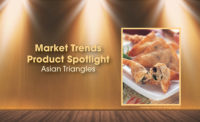![]()
Asian Americans
Marketers in other categories have identified the
potential with this group of smart and well-off consumers, but candy
marketers still have the opportunity to make some inroads.
They’re educated, they’re affluent, and their numbers
are growing rapidly. Who wouldn’t want to target Asian American
consumers?
Lots of companies, it turns out, including most candy marketers.
Lots of companies, it turns out, including most candy marketers.
“The confection category hasn’t been
active in the Asian market,” contends Saul Gitlin, executive vice
president, Kang & Lee Advertising, a New York City-based marketing
consulting/communications agency that specializes in marketing to Asian
Americans. “There is not a chocolate bar manufacturer out there that
is speaking to Asians at all,” Gitlin continues.
Marketers are scared off by the fact that the U.S.
Asian population is so segmented—comprised of Chinese, Filipino,
Asian Indian, Vietnamese, Korean and Japanese subsets, among others. But
that shouldn’t be a deterrent, says Gitlin.
Values and cultural observances vary from one Asian
nationality to the next, but there are significant commonalties among the
various subsets. This means that a marketer can come up with single,
“pan-Asian” marketing/advertising execution that can be adapted
for each sub-group. “It is rare that a client comes to us and says,
‘I have such an abundant budget, let’s do six different
executions,” says Gitlin.
In addition, the Asian American population is
geographically concentrated, so a marketer can target them relatively
easily. More than half (51 percent) of Asian Americans live in three
states—California, New York and Texas, according to Census 2000. In
California, 12 percent of the population is Asian.
Another boon to targeting is the fact that the vast
majority of U.S. Asians are foreign-born, and prefer to see and hear
marketing messages in their native languages.
That’s good news because in-language media buys are efficient
and very cost-effective; rates are much lower than in the mainstream media.
Just $100 will buy a 60-second prime-time radio spot in a key Asian market,
for example.
“The barrier to entry from a cost perspective is very low, and the potential payoff is very great,” says Gitlin.
“The barrier to entry from a cost perspective is very low, and the potential payoff is very great,” says Gitlin.
The Lunar New Year—a holiday observed by
Chinese, Vietnamese and Korean people —provides a good marketing
opportunity for candy makers, Gitlin notes.
Red is the color of good fortune for the Chinese.
Thus, says Gitlin, “It could make sense for M&M [Masterfoods] to
come out with a package of all red M&M’s with an Asian motif on
the package.”
Or, he continues, Hershey might apply its limited
edition marketing expertise to the Asian segment by rolling out a white
chocolate-covered Reese’s Peanut Butter Cup ornamented with a red
dragon—an Asian symbol of good fortune, wisdom and generosity.
Getting distribution in retail chains that cater to
Asian consumers such as the Ranch 99 chain in California is another key
part of an Asian-American outreach strategy.
Taking it to the next level would mean formulating
products designed to appeal specifically to Asian taste buds. Ice cream
makers have developed green tea, red bean and ginger flavor varieties, and
candy makers might do the same.
Finally, it should be noted that since Asian consumers
have a strong preventive health orientation, this segment of the market
might be ripe for targeting with functional confections. n
Measuring the Market
Population Size: 11.9 million
Percent of the Population: 4.2%
Percent Growth Forecast by 2010: 33.3%
SOURCE: U.S. CENSUS BUREAU
Percent of the Population: 4.2%
Percent Growth Forecast by 2010: 33.3%
SOURCE: U.S. CENSUS BUREAU
Merchandising Mandates
Consider reaching out with coupons or other special promotions
via the Internet. Of all population segments, Asian Americans are the most likely
to have a household computer and Internet access. And among Asian American households
with Internet access, 70 percent go online daily.
Use in-language media—in advertising and with point-of-sale materials. The vast majority of U.S. Asians are foreign-born and prefer communications in their native language.
Target Asian Americans with premium-priced confectionery items during prime gifting times of the year. Such an approach has paid off in other categories.
Use in-language media—in advertising and with point-of-sale materials. The vast majority of U.S. Asians are foreign-born and prefer communications in their native language.
Target Asian Americans with premium-priced confectionery items during prime gifting times of the year. Such an approach has paid off in other categories.
Asian American SNAPSHOT
Asian Americans are more likely than any other population
group to have household incomes of $75,000 or above.
Estimated annual buying power in 2003: $344 billion
There are 545 Asian American in-language newspaper, magazine, television and radio media vehicles.
Sources: Kang & Lee Advertising, Selig Center for Economic Growth
Estimated annual buying power in 2003: $344 billion
There are 545 Asian American in-language newspaper, magazine, television and radio media vehicles.
Sources: Kang & Lee Advertising, Selig Center for Economic Growth
Psychographic Profiles
Chinese Americans: Cautious
in personal and business dealings, price-conscious, plan for the long term,
strong emphasis on family and education.
Filipino Americans: Highest
rates of acculturation thanks to English competency, heritage/culture
values similar to Hispanics, strong sense of family and community
preservation, highly religious (predominantly Roman Catholic).
Asian Indian Americans: National
heritage, culture and values are very important, extreme emphasis on
education, highly price/value conscious, but very loyal to strong brands.
Vietnamese Americans: Quality
conscious and value seekers, strong political beliefs, extremely strong
tendency for cultural and community preservation, strong emphasis on family
and education.
Korean Americans: Often
value emotion more than logic, prefer name brands to lower price,
independent and aggressive, strong emphasis on family and education.
Japanese Americans: Value
consensus over individual opinion, value name brands over price, strong
family values, emphasis on education.

